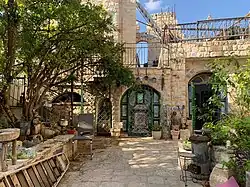Artists Quarter of Safed
The Artists' Quarter in Safed was founded with the liberation of Safed, in the war of independence (1948-49). With the encouragement of the Safed municipality, a group of artists began to restore ruins in the Mamluk neighborhood of Harat al-Wata,[1] on the border of the historic Jewish quarter, to build galleries and open exhibitions. The first artists to settle in Safed however arrived several years beforehand. The first to discover Safed's artistic aura was Isaac Frenkel in 1920 and following him Moshe Castel and Mordechai Levanon in the 1930s.
This attracted dozens of other artists to the Quarter. Integerswas the home of some of the artists, others wandered there, inspired by the spirit of the city, its landscapes, buildings and characters. The gallery workshops and exhibitions were a tourist attraction throughout Kriya's flourishing period in the 1950s and 1960s. To this day a few galleries and museums remain.
Safed's mystic aura invited a wide range of Israeli artists from different art movements. The most notable art movement to adopt Safed was the Jewish School of Paris art movement spearheaded by Isaac Frenkel from the 1920s until the 1970s.[2]
From the 1970s and onward, the Artists' quarter declined in stature. The founding generation passed away, some of the artists did not adapt to changes in artistic fashions and commercialization of art. Neglected infrastructure, lack of state support as well as and demographic changes - the entry of an ultra-Orthodox population into the artists' quarter, have furthered the quarter's continuing decline.[3]
Formation
Before the establishment of the state, some artists had already begun to settle in Safed.[4] Isaac Frenkel one of the first Safed painters, began to paint the city in the 20s of the 20th century [5] and settled in the city as early as 1934. In 1942 Frenkel organized the first exhibition of paintings in Safed, (the entrance fee was only one penny).[4] Frenkel was one of the founders of Safed's Artists' Quarter, although he did not see himself as part of the artists' community of the Quarter and because of this created an alienation between him and the other artists.[4] Seven members of the quarter's founding core of artists include: Shimshon Holtzman, Aryeh Lerner and his painter wife Hanna Lerner, Aryeh Merzer, Isaac Frenkel, Moshe Castel and Menachem Shemi. The artists were given support and encouragement by Safed's first mayor after the 1948 Shuk battles, Moshe Padhzur.
In parallel to the reception of the 'Market Mosque' for the opening of the 'General Exhibition' in which were displayed a selection of the works of the quarter's artists. the 'Kiryat HaOmanim Association' was established. "All the artists who settled in Safed in 1949 were in any case members of the Tel Aviv Artists' Association, and this is how a criterion for accepting new members was formed, which required every candidate to be a member of the national artists' association as a condition for his or her acceptance. Another burdensome law exists in the bylaws, which required every member of the quarter's artists to own a property within the quarter's borders.

Ambience
A 'Mlai club' was established which served as a gathering place for resident artists, guest artists from the center of Israel as well as anyone who wanted to enjoy the bohemian atmosphere and entertainment . The club was operated by a women's committee, the majority of which were the artists' wives, and the minority - artists in their own right. Their role was to organize a program for Friday and Saturday evenings, holiday evenings and a special party was held every year on the occasion of the "end of the season" which took place at the end of Sukkot, before the return of some of the artists to Tel Aviv. Social activity helped to forget the dire economic situation in the years after Israeli independence (austerity). The artists who loved the good life used to pay for their meals in restaurants and hotels with works of art. This is how the hoteliers and restaurateurs of Safed gathered fine art collections.
The School of Paris in Safed
The School of Paris in the Artists' Quarter of Safed of the 1950s and 1960s, was presented in 2014 at the Hecht Museum in Haifa under the curatorship of Sorin Heller. The exhibition examined Safed's artists' connection to the Ecole de Paris. The exhibition presented a variety of works by major artists who worked in this place in the 1950s and 1960s and recounted a unique chapter in Israeli art history.[6]
Many Israeli artists who were heavily influenced by the School of Paris settled in Safed, including Rolly Schaffer, Shimshon Holzman, Mordechai Levanon and other.[6] One of the School of Paris's chief practitioners, Isaac Frenkel Frenel, also lived and worked in Safed. [7]
Today
Although the quarter no longer boasts the impressive artistic population it once had, it still hosts several places of cultural importance. Among them, the "General Exhibition" in the old mosque of the quarter, the Frenkel Frenel Museum, the Beit Castel Gallery, the Makemat School for Oriental Music and more...
References
- https://www.antiquities.org.il/pdf/north31032011.pdf Antiquities Israel Office, on northern Israel
- Ofrat, Gideon. Art and Artists of Safed. p. 189.
- Ofrat, Gideon (2004). In a Local Connection (in Hebrew). p. 29.
- Ofrat, Gideon (1979). "Enough with all the Frenkels". Haaretz. pp. 27–30.
- Frenkel, Eliezer (2008). "My father" (PDF). Eliezer Frenkel's autobiography.
- Heller, Surin (October 2013). "The School of Paris in the Artists' Quarter 1950s 1960s".
- "Alexandre FRENEL". Bureau d’art Ecole de Paris. 2019-01-02. Retrieved 2023-10-18.